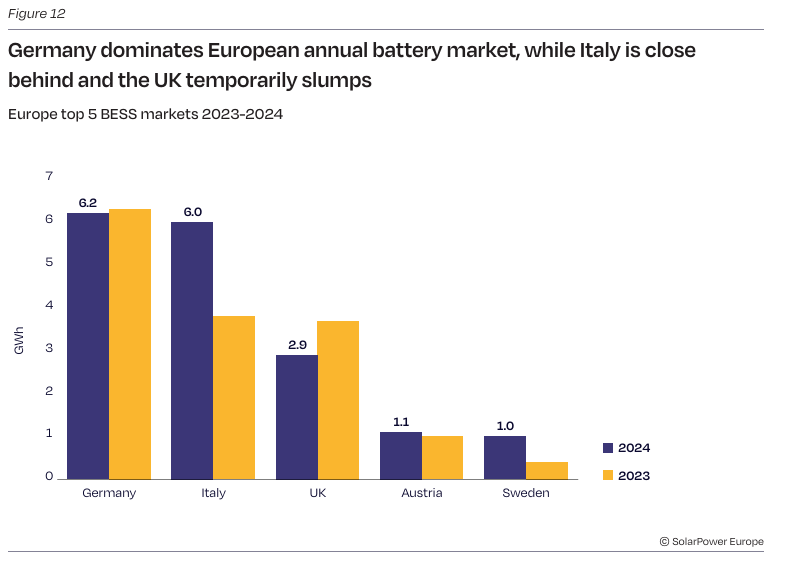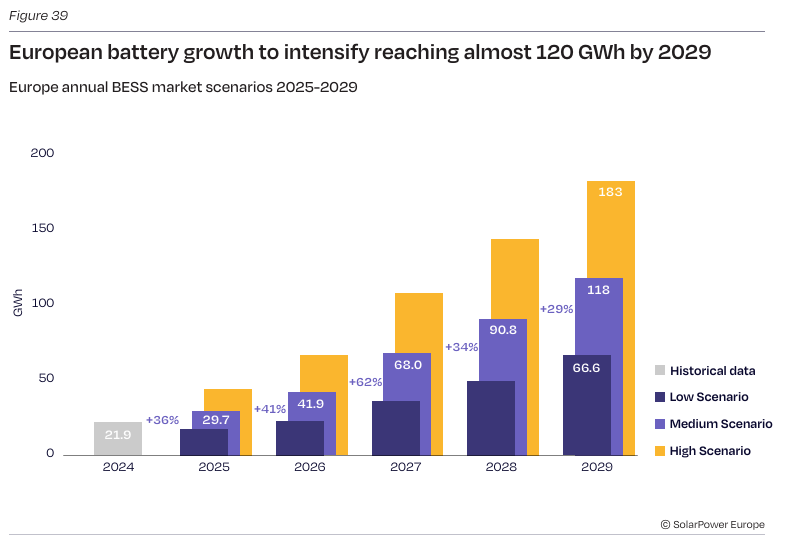The total capacity of battery systems in Europe will reach 400 GWh by 2029, according to the latest report European Market Outlook for Battery Storage 2025-2029, published by the European association SolarPower Europe, of which the RES Association Serbia is a member.
Last year, 21.9 GWh of battery energy storage systems (BESS) were installed, bringing the total battery capacity in Europe to 61.1 GWh. Although household installations have fallen due to the recovery in electricity prices and the removal of subsidies, the market continues to grow thanks to large battery systems becoming the dominant factor.
The report showed that the European battery storage market, which includes all 27 EU member states as well as Switzerland and the United Kingdom, is facing a key turning point – while annual growth slowed to 15% in 2024 after three years of doubling capacity, experts predict an acceleration in the coming years.
Germany, Italy and the UK continue to lead the market and deliver almost 70% of annual capacity
In 2024, the five leading battery storage markets in Europe — Germany, Italy, the UK, Austria and Sweden — have set new standards. Germany retained the top spot despite a decline in home installations and slower growth in larger batteries. Italy has seen a decline in the home battery sector, but a strong increase in large-capacity capacity has fueled its progress. The UK faced a temporary slowdown due to delays in major projects, while Austria and Sweden reached 1 GWh for the first time. This figure shows that the top five countries accounted for 78% of total installed capacity in Europe over the previous year.

Almost twice as many large battery systems in Europe in 2025
In 2025, the battery market is expected to grow rapidly, with a 36% year-on-year increase and the installation of half of the total capacity in 2024. While the market for large battery systems in Europe will almost double in size, household battery installations will decline and the commercial and industrial (C&I) battery segment will continue to grow, albeit at a slower pace.
Energy security, growing use of renewables, economic benefits and new subsidies are driving the expansion of large systems, while improved regulatory and financial conditions are playing a key role in the development of smaller battery installations.

By 2029, the annual European BESS market will be five times larger than by 2024
If current regulatory conditions are maintained, the European battery storage market is expected to grow to 118 GWh per year by 2029, five times more than in 2024. Large battery systems are projected to account for 68% of all new installations by then, while energy storage behind meters will contribute a smaller portion.
Total battery storage capacity in Europe could reach 400 GWh by 2029, and as much as 600 GWh in the optimistic scenario.

Key recommendations of the report
In order to develop BESS in the EU in line with the needs of the energy transition, concrete policy measures are needed, according to SolarPower Europe, calling for the adoption of a dedicated Energy Storage Action Plan as part of the broader EU Flexibility Package.
Also, it is necessary to simplify and reduce the cost of connecting to the grid, provide batteries with full access to electricity markets and ensure stable incomes. Key recommendations also include reforming the balancing market so that batteries participate on an equal footing, as well as improving standards for smart meters and real-time communication. Battery systems will not be able to fully contribute to Europe’s secure, flexible and green energy future.
– If Europe has already entered the solar age, the battery storage age is just beginning. With solar energy mainstreaming across the continent, now is the time for European decisionmakers to put batteries at the centre of a flexible, electrified, energy system – says Walburga Hemetsberger, CEO of SolarPower Europe.
You can read the whole report below:
Cover image: © ABO Energy


